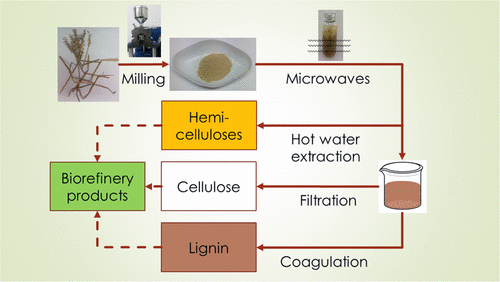Our official English website, www.x-mol.net, welcomes your feedback! (Note: you will need to create a separate account there.)
On the Effect of Hot-Water Pretreatment in Sulfur-Free Pulping of Aspen and Wheat Straw.
ACS Omega ( IF 4.1 ) Pub Date : 2019-12-23 , DOI: 10.1021/acsomega.9b02619 Uula Hyväkkö 1 , Riku Maltari 1, 2 , Tia Kakko 1 , Jussi Kontro 1 , Joona Mikkilä 1, 2 , Petri Kilpeläinen 3 , Eric Enqvist 4 , Panu Tikka 4 , Kristiina Hildén 2 , Paula Nousiainen 1 , Jussi Sipilä 1
ACS Omega ( IF 4.1 ) Pub Date : 2019-12-23 , DOI: 10.1021/acsomega.9b02619 Uula Hyväkkö 1 , Riku Maltari 1, 2 , Tia Kakko 1 , Jussi Kontro 1 , Joona Mikkilä 1, 2 , Petri Kilpeläinen 3 , Eric Enqvist 4 , Panu Tikka 4 , Kristiina Hildén 2 , Paula Nousiainen 1 , Jussi Sipilä 1
Affiliation

|
In modern biorefineries, low value lignin and hemicellulose fractions are produced as side streams. New extraction methods for their purification are needed in order to utilize the whole biomass more efficiently and to produce special target products. In several new applications using plant-based biomaterials, the native-type chemical and polymeric properties are desired. Especially, production of high-quality native-type lignin enables valorization of biomass entirely, thus making novel processes sustainable and economically viable. To investigate sulfur-free possibilities for so-called "lignin first" technologies, we compared alkaline organosolv, formic acid organosolv, and ionic liquid processes to simple soda "cooking" using wheat straw and aspen as raw materials. All experiments were carried out using microwave-assisted pulping approach to enable rapid heat transfer and convenient control of temperature and pressure. The main target was to evaluate the advantage of a brief hot water extraction as a pretreatment for the pulping process. Most of these novel pulping methods resulted in high-quality lignin, which may be valorized more diversely than kraft lignin. Lignin fractions were thoroughly analyzed with NMR (13C and HSQC) and gel permeation chromatography to study the quality of the collected lignin. The cellulose fractions were analyzed by determining their lignin contents and carbohydrate profiles for further utilization in cellulose-based products or biofuels.
中文翻译:

热水预处理对白杨麦秸秆无硫制浆的影响。
在现代生物精炼厂中,低价值的木质素和半纤维素馏分以侧流形式产生。需要新的提取方法对其进行纯化,以便更有效地利用整个生物质并生产特殊的目标产物。在使用基于植物的生物材料的一些新应用中,天然类型的化学和聚合物特性是人们所期望的。尤其是,高质量天然型木质素的生产可以使生物质完全增值,从而使新工艺可持续并在经济上可行。为了研究所谓的“木质素优先”技术的无硫可能性,我们将碱性有机溶剂,甲酸有机溶剂和离子液体工艺与以麦草和白杨木为原料的简单苏打“烹饪”进行了比较。所有实验均使用微波辅助制浆方法进行,以实现快速传热以及方便地控制温度和压力。主要目标是评估短暂热水提取作为制浆过程的预处理的优势。这些新颖的制浆方法大多数都产生了高品质的木质素,与牛皮纸木质素相比,其价格可能更高。用NMR(13C和HSQC)和凝胶渗透色谱法对木质素级分进行彻底分析,以研究所收集木质素的质量。通过测定纤维素级分的木质素含量和碳水化合物谱来分析纤维素级分,以进一步用于基于纤维素的产品或生物燃料中。主要目标是评估短暂热水提取作为制浆过程的预处理的优势。这些新颖的制浆方法大多数都产生了高品质的木质素,与牛皮纸木质素相比,其价格可能更高。用NMR(13C和HSQC)和凝胶渗透色谱法对木质素级分进行彻底分析,以研究所收集木质素的质量。通过测定纤维素级分的木质素含量和碳水化合物谱来分析纤维素级分,以进一步用于基于纤维素的产品或生物燃料中。主要目标是评估短暂热水提取作为制浆过程的预处理的优势。这些新颖的制浆方法大多数都产生了高品质的木质素,与牛皮纸木质素相比,其价格可能更高。用NMR(13C和HSQC)和凝胶渗透色谱法对木质素级分进行彻底分析,以研究所收集木质素的质量。通过测定纤维素级分的木质素含量和碳水化合物谱来分析纤维素级分,以进一步用于基于纤维素的产品或生物燃料中。用NMR(13C和HSQC)和凝胶渗透色谱法对木质素级分进行彻底分析,以研究所收集木质素的质量。通过测定纤维素级分的木质素含量和碳水化合物谱来分析纤维素级分,以进一步用于基于纤维素的产品或生物燃料中。用NMR(13C和HSQC)和凝胶渗透色谱法对木质素级分进行彻底分析,以研究所收集木质素的质量。通过测定纤维素级分的木质素含量和碳水化合物谱来分析纤维素级分,以进一步用于基于纤维素的产品或生物燃料中。
更新日期:2020-01-14
中文翻译:

热水预处理对白杨麦秸秆无硫制浆的影响。
在现代生物精炼厂中,低价值的木质素和半纤维素馏分以侧流形式产生。需要新的提取方法对其进行纯化,以便更有效地利用整个生物质并生产特殊的目标产物。在使用基于植物的生物材料的一些新应用中,天然类型的化学和聚合物特性是人们所期望的。尤其是,高质量天然型木质素的生产可以使生物质完全增值,从而使新工艺可持续并在经济上可行。为了研究所谓的“木质素优先”技术的无硫可能性,我们将碱性有机溶剂,甲酸有机溶剂和离子液体工艺与以麦草和白杨木为原料的简单苏打“烹饪”进行了比较。所有实验均使用微波辅助制浆方法进行,以实现快速传热以及方便地控制温度和压力。主要目标是评估短暂热水提取作为制浆过程的预处理的优势。这些新颖的制浆方法大多数都产生了高品质的木质素,与牛皮纸木质素相比,其价格可能更高。用NMR(13C和HSQC)和凝胶渗透色谱法对木质素级分进行彻底分析,以研究所收集木质素的质量。通过测定纤维素级分的木质素含量和碳水化合物谱来分析纤维素级分,以进一步用于基于纤维素的产品或生物燃料中。主要目标是评估短暂热水提取作为制浆过程的预处理的优势。这些新颖的制浆方法大多数都产生了高品质的木质素,与牛皮纸木质素相比,其价格可能更高。用NMR(13C和HSQC)和凝胶渗透色谱法对木质素级分进行彻底分析,以研究所收集木质素的质量。通过测定纤维素级分的木质素含量和碳水化合物谱来分析纤维素级分,以进一步用于基于纤维素的产品或生物燃料中。主要目标是评估短暂热水提取作为制浆过程的预处理的优势。这些新颖的制浆方法大多数都产生了高品质的木质素,与牛皮纸木质素相比,其价格可能更高。用NMR(13C和HSQC)和凝胶渗透色谱法对木质素级分进行彻底分析,以研究所收集木质素的质量。通过测定纤维素级分的木质素含量和碳水化合物谱来分析纤维素级分,以进一步用于基于纤维素的产品或生物燃料中。用NMR(13C和HSQC)和凝胶渗透色谱法对木质素级分进行彻底分析,以研究所收集木质素的质量。通过测定纤维素级分的木质素含量和碳水化合物谱来分析纤维素级分,以进一步用于基于纤维素的产品或生物燃料中。用NMR(13C和HSQC)和凝胶渗透色谱法对木质素级分进行彻底分析,以研究所收集木质素的质量。通过测定纤维素级分的木质素含量和碳水化合物谱来分析纤维素级分,以进一步用于基于纤维素的产品或生物燃料中。


























 京公网安备 11010802027423号
京公网安备 11010802027423号